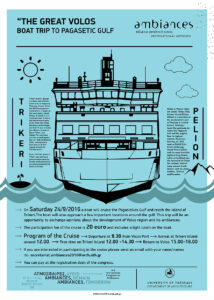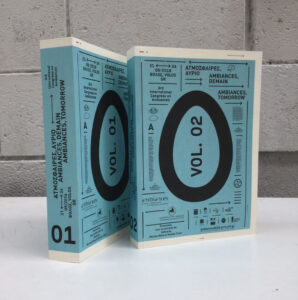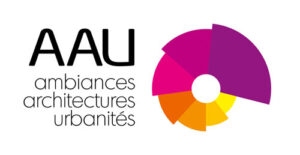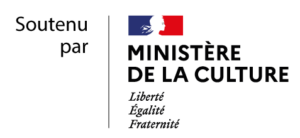
Location
Volos, Greece

Ambiances, tomorrow
For the past 40 years, a large number of researchers, designers and artists in Europe and throughout the world have been focusing on the issue of architectural and urban ambiances. The increasing and enduring importance of the International Ambiances Network demonstrates the topicality of this whole area on a theoretical, critical, practical, experimental and artistic level, as well as from a political, historical and learning perspective. The output of the network members and numerous research teams tackling ambiance-related issues attests to this notion’s ability to re-examine both the knowledge and the production of our living spaces. It constitutes a response to contemporary societal issues such as environmental challenges related to climate change and energy efficiency.
While the first Congress held in Grenoble in 2008 was all about forging a community and taking stock of research and practices in creating architectural and urban ambiances (Faire une ambiance, dir. Jean-François Augoyard), the second Congress held in Montreal in 2012 was able to point up their practical – and even praxeological dimensions, be they of an architectural, urban, social, aesthetic, artistic, political, technical, environmental or pedagogical nature (Ambiances in action, dir. Jean-Paul Thibaud et Daniel Siret). This second congress was therefore useful for rationally mapping out the uses and fields where the notion is at work.
The Third Congress will be used to circumscribe the notion of ambiance (or atmosphere) in a dynamic prospective and demonstrate how it can become an operator in transforming our habitats, cities and societies. So, the future of ambiances can be analysed according to a three-fold perspective in terms of its pragmatic, theoretical and prospective dimensions.
A mature notion with constantly renewed usage (pragmatic dimension)
While the notion of ambiance has demonstrated its capacity to forge an international community and move knowledge and expertise forward, the time has come to analyse these developments, continue showcasing achievements and analyse the whole future of the concept. In other words, the Second Congress provided an answer to « What use do we currently make of the notion of ambiance? » We propose that the Third Congress be used to round out this question with another one, namely, what uses are currently emerging that enable us to envisage and design tomorrow’s architecture, city and regions through the prism of the notion of ambiances.
Numerous researchers and designers draw upon applications from disciplines separated by strict boundaries to design spaces and conduct experiments. The very idea of the designer and subject-agent blend into one insofar as expertise is increasingly widely shared. Contemporary applications in both the social sciences and design, as well as the emergence of digital applications and on-board technologies are also an invitation to re-examine the split between analysis, project and production. As such, the very question of translating ambiances (between senses, disciplines, actors and languages) needs to be tackled head-on.
New unprecedented positioning and hybridation (theoretical dimension)
Changing uses and applications of ambiance-related technologies are daily testimony to increasing inter-disciplinary hybridation. What disciplines are currently focused on the notion of ambiance? How can we redefine their contours, fundamentals, tools and representations? How, where and towards what end do we currently perceive notions of ambiance and atmosphere? The – essentially inter-disciplinary – notion of ambiance has led to an increasing degree of porosity in uses between disciplines and their stakeholders as well as a similar range of experiments.
In particular, we will examine these developments with regard to a number of fertile research fields: architectural theory and criticism, research into urban and territorial conditions, research into the built environment, and the open-ended field of ecology (ecology of perception, ecology of attention and social ecology).
Evolving ambiances – the world yesterday, today and tomorrow (prospective dimension)
The world is changing, both in its built forms and in ways of living in, and inhabiting them. Economics and politics can change radically and sometimes violently in situations we had considered to be stable. The climate and the environment are changing. Territories are being transformed and day-to-day living spaces are undoubtedly undergoing major change. In both the private and the public sphere, sensorial space is being transformed both in appearance and in its forms of activation. There is an increasing degree of crossover between digital and physical space. Changing techniques and know-how renew the ways in which ambiances appear and how they are perceived.
How does the notion of ambiance help in analysing and impacting upon these changes? What ambiances lie along the horizon between a realistic and utopian perspective? What is the world’s ambiantal future? Naturally the symmetrical question to this one is how do we gauge the ambiances of the past and, retrospectively, how were the ambiances of the future perceived in the past? How can we gauge how ambiances are changing between the short- term with its forceful impact, and longer-term changes?
The Third Congress will therefore provide the scientific community, designers and artists with an opportunity to showcase and debate how these developments trace out the future of ambiances and especially how they will be conceived, experienced, felt and practised.
Chairmen
- Nicolas Rémy
Department of Architecture of the Polytechnic School of the University of Thessaly, in Volos, Greece
- Nicolas Tixier
CRESSON, UMR CNRS AAU, Graduate School of Architecture of Grenoble, France
Congress website : http://ambiances2016.arch.uth.gr/en/index.html

The Congress is organized jointly by:
- The Department of architecture of the Polytechnic School of the University of Thessaly, Greece.
- The International Ambiances Network, Scientific Thematic Network of the French Ministry for Culture and Communication, France.
This initiative is supported by:
- Laboratory “Ambiances, Architectures, Urbanités”, CRENAU-CRESSON, integrated research unit, CNRS – French National Centre for Scientific Research, Centrale Nantes, National School of Architecture of Grenoble, National School of Architecture of Nantes, France
- LECAD, Laboratory of Environmental Communication and Audiovisual Documentation, research unit which is part of the University of Thessaly’s architecture department, Greece.
- Bureau of Architectural, Urban and Landscape Research at the French Ministry for Culture and Communication, France
- National School of Architecture of Grenoble, France
- National School of Architecture of Nantes, France
- Grenoble Alpes University, France

Congress coordination
Organizing Committee
Theme development
Scientific Committee
- Adey Peter, Royal Holloway, London, England
- Albersten Niels, Aarhus School of Architecture, Aarhus, Denmark
- Amphoux Pascal, CRESSON ‐ UMR AAU, ENSA Nantes, Nantes, France
- Anderson Ben, Durham University ‐ Department of Geography, Durham, England
- Atienza Ricardo, University College of Arts, Crafts & Design, Stockholm, Sweden
- Augoyard Jean‐François, CRESSON ‐ UMR AAU, ENSA Grenoble, Grenoble, France
- Barles Sabine, University Paris 1 Panthéon‐Sorbonne, Paris, France
- Ben Ayed Alia, ENAU Tunis, Tunis, Tunisia
- Berenstein‐Jacques Paula, Universidade Federal do Bahia, Bahia, Brazil
- Berleant Arnold, Long Island University, New‐York City, United State of American
- Böhme Gernot, Technical University of Darmstadt, Darmstadt, Germany
- Bonnet Aurore, CRENAU ‐ UMR AAU, ENSA Nantes, Nantes, France
- Bossé Anne, CRENAU ‐ UMR AAU, ENSA Nantes, Nantes, France
- Bubaris Nikos, Aegean University, Mytilini, Greece
- Bourdakis Vassilis, University of Thessaly, Volos, Greece
- Brayer Laure, CRESSON ‐ UMR AAU, ENSA Grenoble, Grenoble, France
- Breviglieri Marc, CRESSON ‐ UMR AAU, Genève, Suisse
- Bertolino Monica, Facultad de Arquitectura y Urbanismo, Córdoba, Argentina
- Bitsikas Xenofon, University of Ioannina, Ioannina, Greece
- Carles José‐Luis, Universidad Autónoma de Madrid, Spain
- Charitos Dimitris, National & Kapodistrian University of Athens, Greece
- Chelkoff Grégoire, CRESSON ‐ UMR AAU, ENSA Grenoble, Grenoble, France
- Cuadra Manuel, Universität Kassel, Frankfurt am Main, Germany
- Colafranceschi Daniela, Univ. Mediterranea di Reggio Calabria, Reggio Calabria, Italy
- Demers Claude, GRAP – UQUAM, Quebec, Canada
- Depeau Sandrine, ESO ‐ UMR CNRS, Rennes, France
- Devisme Laurent, CRENAU ‐ UMR AAU, ENSA Nantes, Nantes, France
- Duarte Cristiane, Universidade Federal do Rio de Janeiro, Rio de Janero, Brazil
- Dultra‐Bitto Fabiana, Universidade Federal do Bahia, Savlador de Bahia, Brazil
- Giannisi Phoebe, University of Thessaly, Volos, Greece
- Griffero Tonino, University of Rome Tor Vergata, Rome, Italie
- Hasse Jürgen, J. Wolfgang Goethe‐Universität Frankfurt am Main, Frankfurt, Germany
- Howes David, Concordia University, Canada
- Ingold Tim, University of Aberdeen, Aberdeen, Scotland
- Joanne Pascal, CRENAU ‐ UMR AAU, ENSA Nantes, Nantes, France
- Kakalis Christos P., School of Architecture and Landscape, Edinburgh, England
- Kanarelis Theoklis, University of Thessaly, Volos, Greece
- Kazig Rainer, CRESSON ‐ UMR AAU, ENSA Grenoble, Grenoble, France
- Kuriakoulakos Panagiotis, University of the Aegean Syros, Greece
- Kytö, Meri, University of Tampere, Tampere, Finland
- Kanellopoulos Panagiotis, University of Thessaly, Volos, Greece
- Kivelou Stella, Politic and Communication Sciences of Athens, Athens, Greece
- Koivumaki Aris, Tampere University of Applied Sciences, Tampere, Finland
- Kouros Panos, University of Patra, Patras, Greece
- Labussière Olivier, UMR PACTE, Grenoble, France
- Laplantine François, University of Lyon 2 Lumière, Lyon, France
- Laskaris Nikolaos, National Technical University of Athens, Athens, Greece
- Lazaridis Pantelis, Université of Thessaly, Volos Grèce
- Leduc Thomas, CRENAU ‐ UMR AAU, ENSA Nantes, Nantes, France
- Liveneau Philippe, CRESSON ‐ UMR AAU, ENSA Grenoble, Grenoble, France
- Manolidis Kostas, University of Thessaly, Volos, Grèce
- Mantzou Polyxeni, Democritus University of Thrace, Xanthi, Greece
- Mantziaras Panagiotis, Fondation Braillard Architectes, Genève, Suisse
- Masson Damien, University of Cergy‐Pontoise, Paris, France
- Meigneux Guillaume, CRESSON ‐ UMR AAU, ENSA Grenoble, Grenoble, France
- Melemis Steven, UMR AUSSER, Paris, France
- Meziou Olfa, ENAU Tunis, Tunis, Tunisia
- Morello Eugenio, Polytechnico di Milano, Milan, Italy
- Moraitis Constantinos, National Technical University of Athens, Athens, Greece
- Núñez Adolfo, Universidad Autónoma de Madrid, Spain
- Okamura Cintia, CETESB, São Paulo, Brazil
- Papadopoulos Spiros, University of Thessaly, Volos, Greece
- Papakonstantinou Georges, University of Thessaly, Volos, Greece
- Papadimitriou Spiros I., University of Thessaloniki, Thessaloniki, Greece
- Pecqueux Anthony, CRESSON ‐ UMR AAU, ENSA Grenoble, Grenoble, France
- Péneau Jean‐Pierre, ENAU Tunis, Tunis, Tunisia
- Pichon Pascale, University Jean Monnet, St‐Etienne, France
- Piga Barbara E.A., Polytechnico di Milano, Milan, Italia
- Pinheiro Ethel, FAU/UFRJ, Rio de Janero, Brazil
- Pousin Frédéric, UMR AUSSER, Paris, France
- Psychoulis Alexandros, University of Thessaly, Volos, Greece
- Remy Nicolas, University of Thessaly, Volos, Greece
- Requena Ruiz Ignacio, CRENAU ‐ UMR AAU, Nantes, France
- Rodriguez‐Alcalà Carolina, University of Campinas, Campinas, Brazil
- Saïd Noha, Cairo University, Cairo, Egypt
- Shusterman Richard, Florida Atlantic University, Boca Raton, USA
- Simmonot Nathalie, LéaV ‐ ENSA Versailles, Versailles, France
- Simpson Paul, Plymouth University, Plymouth, England
- Siret Daniel, CRENAU ‐ UMR AAU, ENSA Nantes, Nantes, France
- Spiridonidis Constantin‐Victor, University of Thessaloniki, Thessaloniki, Greece
- Thibaud Jean‐Paul, CRESSON ‐ UMR AAU, ENSA Grenoble, Grenoble, France
- Thomas Rachel, CRESSON ‐ UMR AAU, ENSA Grenoble, Grenoble, France
- Tixier Nicolas, CRESSON ‐ UMR AAU, ENSA Grenoble & ESAAA, Grenoble, France
- Tsangrasoulis Aris, University of Thessaly, Volos, Greece
- Tragaki Daphnée, University of Thessaly, Volos, Greece
- Tsinikas Nikolaos, University of Thessaloniki, Thessaloniki, Greece
- Uimonen Heikki, Sibelius Academy, Helsinki, Finland
- Vrontissi Maria, University of Thessaly, Volos, Greece
- Vyzoviti Sophia, University of Thessaly, Volos, Greece
- Xagoraris Zafos, Athens School of Fine Arts, Athens, Greece
- Zardini Mirko, Canadian Centre for Architecture, Montreal, Canada
- Zerbib David, ESAA Annecy, France
Call for Papers
The selected proposals bring partial responses and arguments relating to the general theme of the Ambiances, tomorrow via six themes.
Particular interest was given to proposals that provide for possible cross-over and hybridation between various different fields and expertise:
- Research that straddles several disciplinary fields.
- Research that combines research practices and design activities.
- Research that incorporates diverse sensorial possibilities.
- Research that draws from both art and science.
1. Ambiantal experiences and experiments
This theme focuses primarily on ambiances in terms of experiences and experiments. Such notions are key to research into ambiances because they pose a dual question about how to gauge ambiances and how to effect them. Experiencing ambiance is as much about being able to act as being able to manipulate or manufacture it.How is such comparative experimentation shared by the scientific community and by artistic initiatives suitable for encouraging thought and action and for highlighting unexpected singularities that could renew our relationship with the world and with doing – both in design processes and in the constant updating of a situation?
Framing the question of ambiances in terms of experimentation opens new possibilities by focusing on multiple technical, social or aesthetic standards currently in force. Starting with an exploration and production of spaces and uses, the focus is on clarifying arrangements, processes and experimentation support media. This session seeks contributions that are underpinned in some way or other by research highlighting different forms of experience, either through a specific type of production (space, arrangement, materiel object, work, site, medium, etc.) that makes it possible to deliberately alter a habitat, or through practical experiments that combine physical, sensorial and social dimensions.
2. Traces, notations and representations of ambiances
If we take the three terms « traces », « notations » and « representations » either separately or together as processes, how can we gauge ambiances – or have them gauged – in terms of their tangible, intangible and mutable qualities within a perspective in which territories, spaces and the environment are experiencing huge changes (urbanism, climate, etc.)? What traces do experiences of ambiances leave and what traces can we leave of such experiences? What experiences of notations and representation(s) can research draw upon within the perspective of a « future of ambiances »?
At the present time, when there is an overlap between research and design in the pre-project phase, there is a genuine window of opportunity for the future of ambiances. In the light of traces, ratings and other representations, would any expression of ambiances not be an operative moment that forges a link with design and with this posture whose tricky task it is to design spaces and use these to produce experiences. What is actually representable in an ambiance? How and by means of which media may we produce an expression of ambiances?
3. Projecting and manufacturing the ambiances of tomorrow
The world around us is in a constant state of adaptation. People, places and sensorial information interact as part of an unlimited dialogue. The new ways of envisaging the materiality and virtuality of our still-gestating world will undoubtedly make it possible to produce unprecedented architectural and urban experiences in terms of both tailored solutions and more comprehensive offerings. What part will mobiquity (mobility + ubiquity) and augmented reality play in these restructured interactions of the subject with its sensorial environment? What adaptations may we expect for the sensorial citizen vis-à-vis his or her social environment? Is the future of the world all-phygital (physical + digital)?
How are these changes transforming design processes and project methodologies? How do they contribute to renewing the very framework of architectural production? How do designers3appropriate the hybridation of digital and physical universes in their projects and how do these new digital applications renew the conception of ambiances in tomorrow’s world?
4. Ambiance, atmosphere, climate: theory, politics and criticism
Methodological issues on how to gauge ambiances are related to theoretical and critical imperatives. We invite participants to clarify them, especially the respective reach of the notions of ambiance, atmosphere and climate. Ambiances affect us politically. Certain atmospheric « dissonances » can sometimes trigger strong emotions and disagreements. In other words, a highly-charged atmosphere/ambiance affects our behaviour while remaining difficult to gauge and to describe clearly. Atmospheres are shared but they can divide. Cities, urban landscapes and countries are criss-crossed by atmospheric charges, powers and resistance. How can we describe, conceptualise, theorise and criticise these?
The Arab Spring, indigenous movements, Occupy Wall Street, Republican protests in France, anti-austerity protests in Europe, etc. – contemporary urban public spaces everywhere are being used to hear and relay the calls of citizens to « change the world ». Although these peaceful occupations and/or collective marches enjoy a large media echo and lend a particular tone to the televisual or radio landscape or to the World Wide Web – other less obvious or proactive movements with a lower profile, and sometimes emanating from the private sphere, are helping to slowly reconfigure the sensorial framework of the urban experience and contemporary urbanites. How is it possible to gauge and describe these transformations at work when most of them are part of long, pending or incomplete processes underpinned by complex socio-political issues? How can a focus on the socio-political dimension of ambiances/atmospheres foster a critical reflection concerning the sensorial evolution of the urban world?
5. Ambiances and territories in transformation
Contemporary societies are now more than ever in a dynamic of change that impacts the production of space and lifestyles. In particular, globalisation and digitisation can be seen as two key vectors in this dynamic that ceaselessly transforms urban territories and their periphery as well as rural areas. We wish to tease out the sensorial dimension of these changes, firstly by analysing their impacts on the environment and practices and also in order to envisage the roles (technical, political, performative, etc.) of ambiances in the production of tomorrow’s territories.
We believe three avenues are particularly worth exploring in this respect. The first concerns the production of territories and constructing approaches and images concerning their competitiveness. The second focuses on the spaces produced and the day-to-day situations rendered possible and seeks to analyse their capacity for including or excluding inhabitants. It also examines the overlap between different worlds and between real and virtual spatialities in the experience of places. Lastly, the third avenue focuses on the spatial and temporal scales concerned by these transformations and their implications for understanding how these territories are set to evolve.
6. Ambiance as heritage of the future
Can we make ambiance part of heritage? In other words, can we safeguard the ephemeral and intangible qualities of a place in order to transform it physically? Or, put another way, can we make a territory part of heritage through ambiance, i.e., transform certain physical aspects without destroying the spirit of the place and the way in which it « makes » territory?
We are familiar with the effects of folklorisation, dehumanisation or loss of authenticity that stem from over-exclusive comprehensive protective measures, radical changes in use or historical reconstructions that are just too perfect. We succeed in protecting the material itself but we have turned it into an image or a pure representation and we have destroyed the ambiance (take, for example, the use to which the notion is put in cultural tourism policies or in sensorial marketing).
But we also know of certain architectural reconversion or urban renovation projects that do succeed in preserving the quality of the original buildings or streets while also adding in the improvements necessary for contemporary day-to-day living. They reinforce a sensorial memory in line with the necessary evolution of societies and their edifices. So, is ambiance not the instrument par excellence for constituting the heritage of the future?
To put it another way, the contention underlying this thematic focus could be expressed as follows: « Constituting heritage » previously consisted of classifying « architectural objects » to protect their tangible substance; nowadays, it involves identifying « urban entities » in order to preserve their intangible substrate, and tomorrow it may very well consist in enhancing « territorial ambiances » to safeguard them over time through contemporary forms and lifestyles.
Parallel Sessions
Dialogues
Sim[pli]city
Ephemeral library
Volos Transect
Thematic Workshops
Concert & Performances
Exhibition

Excursion the Great Volos
| Ambiances, demain | Ambiances, tomorrow | Ατμόσφαιρες, Αύριο Edited by Nicolas Rémy & Nicolas Tixier © International Ambiances Network & University of Thessaly, 2016 1 016 p. (2 volumes) 50 € – ISBN 978‐2‐9520948‐6‐3 Order by email |
Liste des auteurs | Index of Authors
|
ABBAS Yasmine ABU DAYA Amal ABUHN Beata L ALBERTSEN Niels ALVES Susana AMAMOU Ines AMMAR Toumadher ANDERSEN Marilyne ARIZAGA Ximena ATIENZA Ricardo ATTALI Jean ATTIA Amr Abdalla Abdelaziz AUGOYARD Jean‐François BALAMANE Nadia Hamzaoui BALAΫ Olivier BALEZ Suzel BARNIAUDY Clément BEGEL Antoine BEL HAJ HAMOUDA CHERIF Alia BELAKEHAL Azeddine BEN AYED Alia BEN FRAJ Fatma BEN HADJ SALEM Mohsen BENDIB Houda BENKORICHI Oualid BERRENS Karla BODE Imme BOFFI Marco BONICCO‐DONATO Céline BONNET Aurore BOSSÉ Anne BRAYER Laure BREVIGLIERI Marc BUYCK Jennifer CAGLAR Alper Harun CALVET‐MIR Laura CARLES José Luis CASAULT André CHAMILOTHORI Kynthia CHARITOS Dimitris CHELKOFF Grégoire CHIARINI Cecilia CHTARA Chiraz CRUNELLE Marc DAICH Safa DAICHE Ahmed Motie DE MARCO Rosa DEFFNER Alex DEMERS Claude DEROUICHE‐JERBI Malek DESMICHEL Pascal DIMITRIADI Leda DOUTRIAUX Emmanuel DROZD Céline DUARTE Cristiane Rose DUBOS Anne ELVIRA Juan ESCHER Anton FARSØ Mads FAUCON Frédéric FEILDEL Benoit FELIX‐FROMENTIN Clotilde FRIBERG Carsten GALLIGO Igor GARCÍA SÁNCHEZ Pedro José GAUDIBERT Piotr GEISLER Élise GERMON Olivia GHARBI Salma GHOZI Raja GILBERT Jacques Athanaze GOURLOT Nathalie GUILLÉ Marien HASSAN Doaa K. HEIBACH Christiane HUGONNET Christian HUSSEIN Faten JÄGGI Patricia JAIDANE Meriem JEUDY Olivier KAKALIS Christos KARNER Marie KAROUI Hind KAZIG Rainer KERZ Christina KIOUPKIOLIS Alexandros KOIVUMÄKI Ari KONTUKOSKI Maija KYRIAKOPOULOS Leandros KYTÖ Meri LABURTE Dominique LAGO Noémie LALOU Georgia LANDOULSI ATTIA Imen LAPRAY Karine LAROCHE Sylvie LAYEB Sana LE CARRER Héloïse LEBOIS Valérie LEROY Marie LESCOP Laurent LIVENEAU Philippe LLORCA Joaquín LOLIVE Jacques M’HAMMEDI Mouna MACE Valérie MADOEUF Anna MADSEN Theis Vallø MADSEN Tina Anette MANOLA Théa MANTAS Neoklis MARCHAL Théo MARCOU Marie MARGIER Antonin |
MARIE Héloïse MASSON Damien McCAFFERTY Conor MEIGNEUX Guillaume MELEMIS Steven MEUNIER Virginie MEZIOU Olfa R. MILLIOT Virginie MINVIELLE Nicolas MONS Alain MONSHIZADE Arezou MORELLO Eugenio MÜLLER Anna‐Lisa MYGDALI Stella OKAMURA Cintia OSBORNE Tess PAGNAC‐BAUDRY Héloïse PALMESE Cristina PARIS Magali PEREZ‐MUNOZ Antoine PERRIER Olivier PETERSEN Rikke Munck PHILIPPE Anne PICHON Pascale PIGA Barbara E A PINHEIRO Ethel PITKÄKOSKI Tuija PLANCHOT Mathilde POIRIER Geneviève POLACK Jean‐Dominique POTVIN André POULAT Olivier R. DONGRE Alpana RAINISIO Nicola RAPP Helena RASPAUD Michel REDONDO Belinda REGNAULT Cécile REMY Nicolas REQUENA‐RUIZ Ignacio RIEDEL Friedlind ROMBACH Emmanuelle ROMIEU Patrick ROUX Jean‐Michel RUNKEL Simon SAADI Mohamed Yacine SAID Noha G. SANCOVSCHI Ilana SAND Monica SAPOUNAKIS Aris SEGAPELI Silvana SERVIÈRES Myriam SIGNORELLI Valerio SIMON Andreas SIMONNOT Nathalie SIRET Daniel SLAMA Imène SOMMERLAD Elisabeth SPANOU Ioanna STEFANOU Danae SUNER Bruno SZÁNTÓ Catherine THEODORSON Judy THEONA Iouliani THIBAUD Jean‐Paul THIOLLIERE Pascaline THULIN Samuel TIAZZOLDI Caterina TIXIER Nicolas TORPUS Jan TORRES ASTABURUAGA Adrián TORRES GARCIA Jesús TOURRE Vincent TOUSSAINT Maïlys TRAGAKI Dafni TRIBOUT Silvère TSAVDAROGLOU Charalampos UIMONEN Heikki VARANO Sandro VASILIKOU Carolina VAYSSIERE Bruno VEGETTI Irene VERMEIRE Geert VYZOVITI Sophia WAHURWAGH Amit J. WHEELER Andrea WIECZOREK Izabela WIENOLD Jan WOLOSZYN Philippe ZAÏRI Mouna ZAVRAKA Despoina ZEMMOURI Noureddine ZIDELMAL Nadia ΓΡΗΓΟΡΙΑΔΟΥ Μαγδαληνή ΔΕΦΝΕΡ Αλέξιος ΖΑΒΙΤΣΑΝΟΥ Αβροκώμη ΚΑΤΣΑΦΑΔΟΥ Σωτηρία ΛΟΥΚΑΚΗΣ Γιώργος ΜΑΝΤΖΟΥ Πολυξένη ΜΑΝΩΛΙΔΗΣ Κώστας ΜΑΡΑΓΚΟΥ Αφροδίτη ΜΕΡΜΙΓΚΗ Δήμητρα ΜΠΑΝΤΟΥΝΑ Δάφνη ΜΠΟΥΡΔΑΚΗΣ Βασίλης ΠΑΞΙΝΟΥ Ευαγγελία ΠΑΠΑΔΗΜΗΤΡΙΟΥ Σπύρος Ι. ΠΑΠΑΔΟΠΟΥΛΟΣ Σπύρος ΠΑΥΛΙΔΗ Ναταλία ΠΡΙΓΚΟΥ Σταματία ΤΟΛΟΥΔΗ Ζηνοβία ΤΣΑΚΙΡΗ Ευφροσύνη ΧΑΤΖΗΣΑΒΒΑ Δήμητρα ΧΡΟΝΑΚΗ Μυρτώ |




